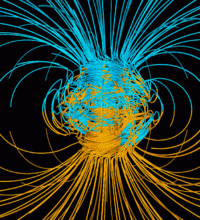
Photo from wikipedia
Abstract We investigate the geomagnetic field variations recorded by INTERMAGNET geomagnetic observatories, which are observed while the Moon’s umbra or penumbra passed over them during a solar eclipse event. Though… Click to show full abstract
Abstract We investigate the geomagnetic field variations recorded by INTERMAGNET geomagnetic observatories, which are observed while the Moon’s umbra or penumbra passed over them during a solar eclipse event. Though it is generally considered that the geomagnetic field can be modulated during solar eclipses, the effect of the solar eclipse on the observed geomagnetic field has proved subtle to be detected. Instead of exploring the geomagnetic field as a case study, we analyze 207 geomagnetic manifestations acquired by 100 geomagnetic observatories during 39 solar eclipses occurring from 1991 to 2016. As a result of examining a pattern of the geomagnetic field variation on average, we confirm that the effect can be seen over an interval of 180 min centered at the time of maximum eclipse on a site of a geomagnetic observatory. That is, demonstrate an increase in the Y component of the geomagnetic field and decreases in the X component and the total strength of the geomagnetic field. We also find that the effect can be overwhelmed, depending more sensitively on the level of daily geomagnetic events than on the level of solar activity and/or the phase of solar cycle. We have demonstrated it by dividing the whole data set into subsets based on parameters of the geomagnetic field, solar activity, and solar eclipses. It is suggested, therefore, that an evidence of the solar eclipse effect can be revealed even at the solar maximum, as long as the day of the solar eclipse is magnetically quiet.
Journal Title: Advances in Space Research
Year Published: 2018
Link to full text (if available)
Share on Social Media: Sign Up to like & get
recommendations!